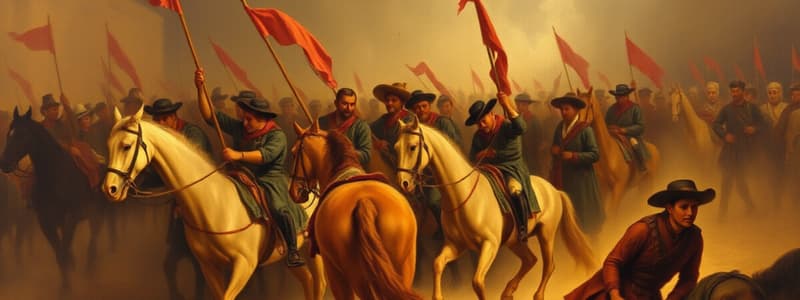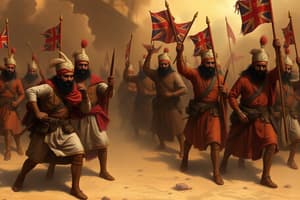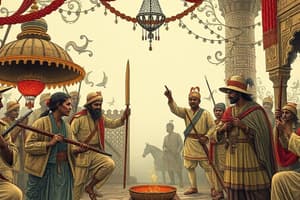Podcast
Questions and Answers
What was the primary function of the East India Company before it gained political control in India?
What was the primary function of the East India Company before it gained political control in India?
The primary function was trade.
How did the Doctrine of Lapse facilitate British territorial expansion in India?
How did the Doctrine of Lapse facilitate British territorial expansion in India?
It allowed annexation of princely states without a male heir.
What were two land revenue systems introduced by the British, and what was their impact?
What were two land revenue systems introduced by the British, and what was their impact?
Zamindari and ryotwari systems were introduced, leading to increased taxation and peasant unrest.
What triggered the Sepoy Mutiny of 1857?
What triggered the Sepoy Mutiny of 1857?
List two major battles that occurred during the Sepoy Mutiny.
List two major battles that occurred during the Sepoy Mutiny.
What was one major consequence of the Sepoy Mutiny for British administration in India?
What was one major consequence of the Sepoy Mutiny for British administration in India?
How did British policies lead to deindustrialization in India?
How did British policies lead to deindustrialization in India?
What was the impact of focusing on cash crops in India during British rule?
What was the impact of focusing on cash crops in India during British rule?
How did Western education contribute to social change in India?
How did Western education contribute to social change in India?
What role did religious reform movements play in Indian society during British colonial rule?
What role did religious reform movements play in Indian society during British colonial rule?
Flashcards are hidden until you start studying
Study Notes
Colonial Policies
- East India Company: Initially established for trade, gradually gained political control over territories.
- Doctrine of Lapse: Annexation policy that allowed the British to take control of princely states without a male heir.
- Land Revenue Systems: Introduced systems like zamindari and ryotwari, leading to increased taxation and peasant unrest.
- Legal Reforms: Established British legal systems; codified laws and introduced Western education.
Sepoy Mutiny (1857)
- Causes: Discontent among Indian soldiers (sepoys) due to cultural insensitivity, low pay, and poor treatment.
- Key Events:
- Outbreak in Meerut, spreading to Delhi and other regions.
- Major battles at Kanpur, Lucknow, and Jhansi.
- Consequences:
- End of the East India Company's rule; direct control transferred to the British Crown.
- Reorganization of the Indian Army and increased British military presence.
Economic Impact
- Deindustrialization: Traditional industries suffered due to British policies favoring imports over local production.
- Agricultural Changes: Focus on cash crops (e.g., cotton, indigo) led to food shortages and famines.
- Infrastructural Development: Railways, roads, and telegraphs introduced primarily for military and economic exploitation.
- Wealth Drain: Systematic extraction of resources led to economic exploitation and poverty in India.
Cultural Changes
- Western Education: Spread of English education and Western ideals; rise of a new educated Indian middle class.
- Social Reform Movements: Emergence of movements addressing social issues (e.g., caste discrimination, women's rights).
- Religious Reform: Revivalist movements (e.g., Arya Samaj, Brahmo Samaj) sought to reform Hindu practices.
- Cultural Nationalism: Growth of a sense of Indian identity, ultimately leading to political mobilization.
Indian Independence Movement
- Early Nationalism: Formation of Indian National Congress (1885) as a platform for political reform and representation.
- Key Figures: Leaders such as Mahatma Gandhi, Jawaharlal Nehru, and Subhas Chandra Bose emerged to lead the movement.
- Mass Movements: Significant events include the Non-Cooperation Movement (1920), Civil Disobedience Movement (1930), and Quit India Movement (1942).
- Partition of India (1947): Led to the creation of India and Pakistan, marking the end of British colonial rule.
Colonial Policies
- East India Company: Transitioned from a trading entity to a ruling authority, controlling vast territories in India.
- Doctrine of Lapse: Strategic policy enabling British annexation of Indian states lacking a male heir, further consolidating control.
- Land Revenue Systems: Implementation of zamindari and ryotwari systems increased tax burdens on farmers, inciting widespread unrest.
- Legal Reforms: Introduction of British legal frameworks, codification of laws, and establishment of Western-style education systems.
Sepoy Mutiny (1857)
- Causes: Widespread discontent among sepoys due to cultural insensitivity, inadequate remuneration, and poor treatment by British officers.
- Key Events:
- Initial uprising in Meerut led to a rapid spread of rebellion in Delhi, Kanpur, Lucknow, and Jhansi.
- Consequences:
- Dismantling of East India Company's rule and direct governance by the British Crown followed by a restructured Indian Army and greater military oversight.
Economic Impact
- Deindustrialization: Traditional industries faced decline as British policies prioritized imported goods, undermining local production capabilities.
- Agricultural Changes: Shift towards cash crops like cotton and indigo resulted in agricultural neglect, causing food scarcity and recurrent famines.
- Infrastructural Development: Railways, roads, and telegraph systems developed primarily to support military operations and economic extraction.
- Wealth Drain: Consistent resource extraction caused significant exploitation, contributing to widespread poverty across India.
Cultural Changes
- Western Education: Proliferation of English language education fostered a new educated middle class familiar with Western ideals.
- Social Reform Movements: Emergence of initiatives addressing social injustices, including discrimination and women's rights advocacy.
- Religious Reform: Revivalist movements like Arya Samaj and Brahmo Samaj sought to modernize and reform Hindu practices.
- Cultural Nationalism: Increasing awareness of Indian identity and heritage laid the groundwork for political mobilization against colonial rule.
Indian Independence Movement
- Early Nationalism: Establishment of the Indian National Congress in 1885 served as a platform for advocating political reform and Indian representation.
- Key Figures: Influential leaders such as Mahatma Gandhi, Jawaharlal Nehru, and Subhas Chandra Bose played pivotal roles in mobilizing the movement.
- Mass Movements: Major actions included the Non-Cooperation Movement (1920), Civil Disobedience Movement (1930), and Quit India Movement (1942), each marking a significant escalation in resistance against colonialism.
- Partition of India (1947): Culminated in the division of India and Pakistan, representing the conclusion of British colonial dominion over the subcontinent.
Studying That Suits You
Use AI to generate personalized quizzes and flashcards to suit your learning preferences.





